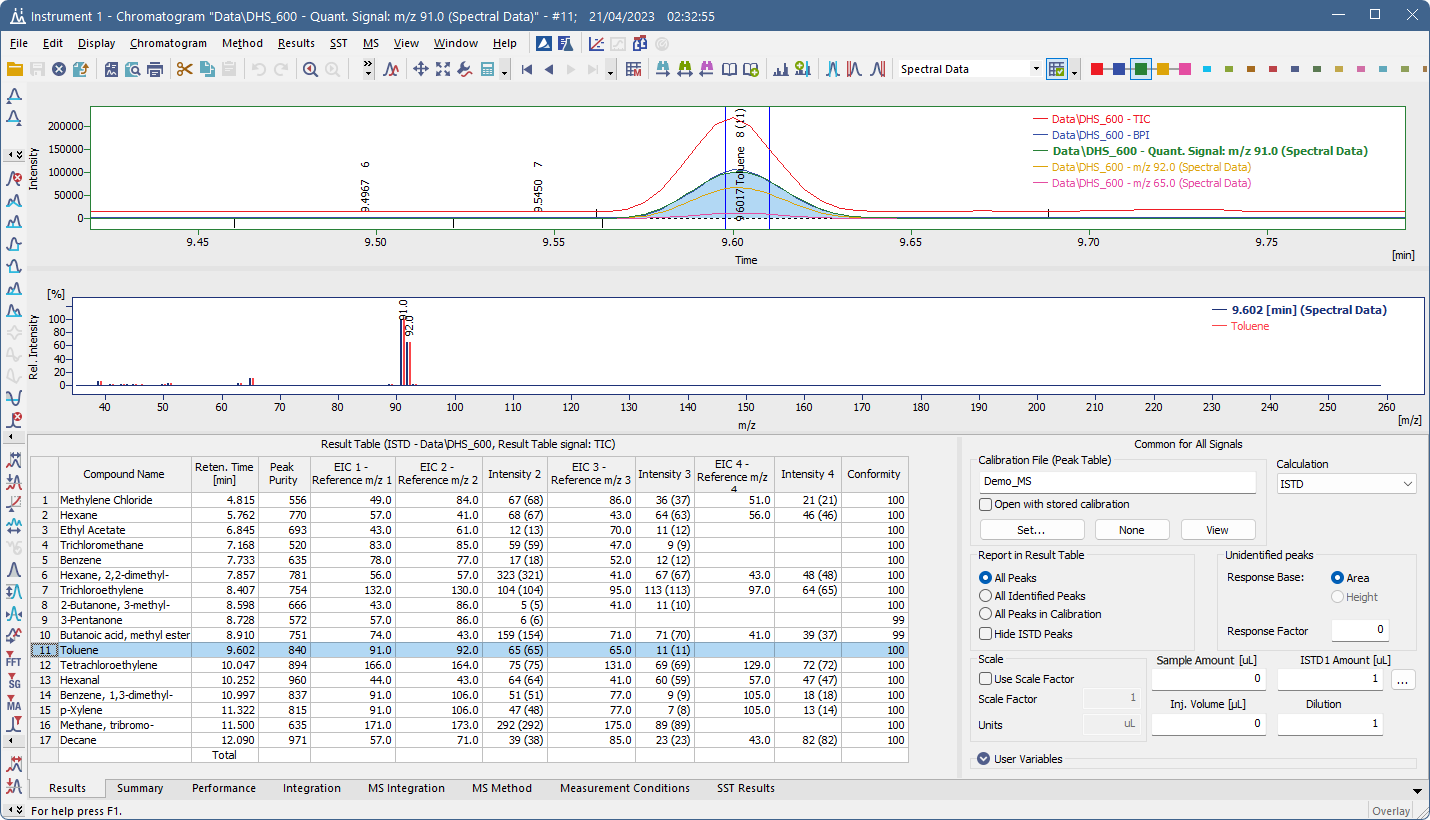MS Chromatogram window
The MS Chromatogram window is used on GC-MS-MS and LC-MS-MS instruments instead of the standard Chromatogram window. It offers similar functionality but includes specific features related to tandem mass spectrometry. This section focuses only on the differences and additional features specific to the MS Chromatogram window.

MS Chromatogram window
Spectral graph
The graph area is divided into two parts:
- Chromatogram (top graph) – shows selected signals over time, such as TIC, BPI, quantification m/z, and reference m/z signals.
- Spectrum (bottom graph) – displays the mass spectrum corresponding to the selected time or compound.
In MS-MS chromatograms, each peak is typically associated with a dedicated MS² spectrum. The Select Spectral Data drop-down is essential here, as it allows switching between available spectra. This control is located in the MS toolbar.
Clicking on a peak in the chromatogram, selecting a compound in the MS Method Table, or using the Result Table updates the spectrum (and possible selected Spectral Data) accordingly. If a library spectrum is available, the bottom graph displays it as an overlay for comparison. This overlay is shown only in the spectral graph.
To display the spectrum for any part of the chromatogram manually, use the MS - Show Spectrum command.
The spectral graph typically shows relative intensity vs. m/z. This can be changed to absolute intensity and the labeling of m/z lines adjusted using the Graph Properties - MS Spectra dialog (via the Properties… command in local menu).
MS Offsetting
A special display mode called MS Offsetting lets you visually align signals to the same baseline while keeping their relative intensities. This is useful for comparing signals (e.g. TIC vs. reference ions) and minimizing background noise. You can enable it in the Graph Properties - Signals dialog.
Spectral data in MS-MS Extension
During an MS-MS experiment, data are typically stored in multiple spectral data structures, depending on the settings of the MS-MS detector control module. Clarity distinguishes between two basic types of data structures:
- Scan-like data – A collection of full spectra, where each spectrum contains intensity values across a continuous m/z range. These spectra share the same Start m/z, End m/z, and constant m/z step size. When displayed, all m/z values in a spectrum share the same retention time.
- SIM-like data – A set of individual m/z signals, each with its own metadata (such as how it was measured or its purpose). These m/z values are not sampled at exactly the same retention time, but for display purposes, the closest available data point is shown.
Multiple such structures can coexist, and their acquisition may start and end at different times than the overall chromatogram.
Each compound in the MS Method table that uses EIC or a summed signal for quantification must be linked to a specific data structure. This is done via the hidden Spectral Data column in the MS Method table. When a compound is added, this column is filled with the currently selected spectral data in the Select Spectral Data drop-down.
Different compounds may reference different spectral data structures. The active selection affects many functions – for example, Show Spectrum will limit the cursor to the valid range of the selected data structure, and spectral searches will only run within that range.
Signals in MS-MS Extension
The type and number of displayed signals depend on the selected compound. Different peaks can have different quantification and reference signals, and the visible signals may update dynamically based on the current selection.
Signals appear in the following order:
- Standard signals defined in System Configuration or Method Setup.
- Quantification signal of the selected peak – this can be one of the reference m/z signals, TIC, their sum, or even an external signal
- Reference ion signals of the selected peak. If a reference ion is also used as a quantification signal, it is shown only once.
- User-created temporary signals – additional signals generated on-the-fly from raw data.
A maximum of 32 signals can be displayed for one MS chromatogram. This includes standard, reference, TIC, BPI, external, and temporary signals, it is not possible to display temporary signal that would exceed this number.
Temporary signals are created on-the-fly from raw data and are not part of the chromatogram file itself. They are visible only on MS instruments and are regenerated whenever needed.
They include:
- All EIC (Extracted Ion Chromatogram) signals used for reference or quantification
- Any summed signals derived from multiple m/z values (e.g. sum of references)
- User-defined signals created by Add Temporary Signal command. These signals disappear after you close the Chromatogram window and have to be set again if needed.
View Menu
Maximize Spectrum
The command maximizes the spectrum to cover the entire window (hides the bottom tabs). Double click near the splitter (the cursor will change to  ) to achieve the same effect.
) to achieve the same effect.
Show All
The command restores default view showing chromatogram, spectrum and the bottom tabs.
More MS features in Chromatogram window
Changes and new features specific to the MS Chromatogram window that require additional explanation are described in these dedicated sections: